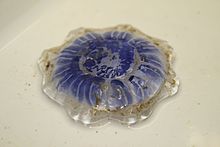Blue nettle jellyfish
| Blue nettle jellyfish | ||||||||||||
|---|---|---|---|---|---|---|---|---|---|---|---|---|

Blue nettle jellyfish ( Cyanea lamarckii ) |
||||||||||||
| Systematics | ||||||||||||
|
||||||||||||
| Scientific name | ||||||||||||
| Cyanea lamarckii | ||||||||||||
| Péron & Lesueur , 1810 |
The blue nettle jellyfish ( Cyanea lamarckii ) is a species from the order of the flag jellyfish . The conspicuous species is also found in the North and Baltic Seas, where it is one of the few jellyfish species that occur more frequently and that can also be unpleasant for humans, alongside the yellow hair jellyfish ( Cyanea capillata ) and the compass jellyfish ( Chrysaora melanaster ). Touching the tentacles triggers the nettle cells, which penetrate the skin with the nettle tube and inject a poison. The skin reddens and swells in places. Allergic reactions are also possible.
description
The blue nettle jellyfish has an umbrella diameter of up to 30 centimeters, its umbrella is strongly thickened in the center and thins towards the edge.
On the underside of the umbrella there are hollow tentacles in eight horseshoe-shaped to rectangular groups of 40 to 60 pieces each, which can be up to 100 centimeters long in very large specimens. Nettle cells protrude in groups from the surface of the screen . Regardless of their name, the color varies from transparent to pale yellow or pale brown to gray to light blue or purple, young specimens are often still colorless. In the case of strongly blue-colored specimens, the inner structure of the umbrella is clearly drawn.
The short and thick manubrium (the oral tube), located in the center of the underside of the screen, merges into four broad lips, folded like a curtain, which can be yellow to whitish in color; the thick mouth arms are slightly shorter than the umbrella diameter. The four pale pink gonads lie around the arms of the mouth and hang freely from the underside of the screen.
The blue nettle jellyfish is similar to the related yellow hair jellyfish ( Cyanea capillata ). It can be distinguished from this on the basis of its size ( C. capillata reaches an umbrella diameter of up to 50 centimeters), its color ( C. capillata is dark red to brown) and the number of marginal tentacles ( C. capillata : 70 to 150 per group).
Way of life
The animals feed on larger zooplankton such as Hydrozoa . To catch them, they interrupt their swimming movements, spread their edge tentacles like a net and sink into the water.
distribution
Blue nettle jellyfish can be found from Scandinavia to the Atlantic, in the North Sea and the Baltic Sea. They are pelagic animals, so they live free-swimming in open water.
proof
- M. Sabatini: Cyanea lamarckii. Blue jellyfish. , in: Marine Life Information Network: Biology and Sensitivity Key Information Subprogramme, Plymouth: Marine Biological Association of the United Kingdom, Online , accessed October 1, 2007
- Thomas Merck, Wulf Greve: Scyphomedusen of the German Bight , Publ. Wiss. Movie. Biol. 22 (1995), pp. 37-48, PDF Online
